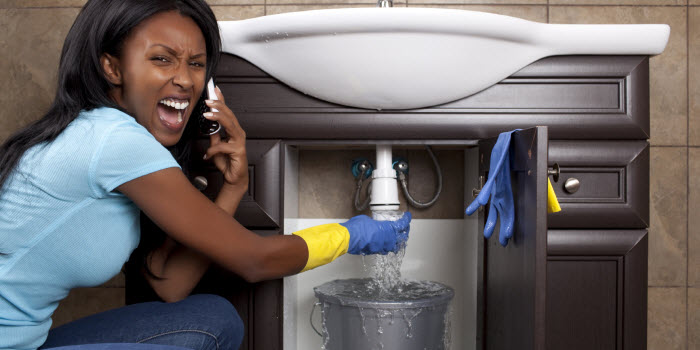There are few things as terrifying to a homeowner as gushing or overflowing water in a plumbing emergency. Water damage is expensive to fix and the dampness left even after cleanup can lead to dangerous mold. Examples of plumbing emergencies include burst water pipes, sewer line blockages, and water heater leaks. If you find yourself in one of these difficult situations, it’s important not to panic. There are certain measures you should take to minimize the damage, such as:
- Shutting off the water supply. When you see water gushing or overflowing, the most important thing to do first is to cut the water supply to reduce the change of severe damage. There are usually two different shut-off valves that can accomplish this. Your house valve is normally located in the basement, garage or on an exterior wall of the house near other utilities. Closing this keeps water from flowing into the house. The second option is closing the valve at your water meter. This prevents water from even flowing through your main line to your stop box. Make sure that you know where both of these valves are and have a plan in case of an emergency.
- Turning off your water heater. Even if your situation does not directly involve a broken water heater, if you’ve followed our first tip, you could be putting it at risk. Water heaters need to be completely filled to work properly. When you shut off your water, your water heater will be drained. So if you leave it on, you could be causing it serious damage.
- Closing your isolation valves. If your issue is located at a faucet, sink or toilet, there are usually individual valves that can be shut off. This isolates the problem and will stop the gushing while still allowing the rest of your home to continue to have water. Check underneath the faucets or sinks and behind the toilet to find these valves.
- Opening outdoor spigots. Once you’ve closed your shut-off valve, the water that is still in your pipes has to go somewhere. You don’t want it going to your problem area and contributing to more damage. To reduce water pressure and give the water more outlets, open your outdoor spigots.
- Calling in the experts. Since water emergencies can be such important situations, you are going to want to get the advice of a professional if there is no obvious fix. Toilet or drain clogs can usually be fixed by the homeowner through the use of a plunger or drain snake. Anything more serious than that and you’ll want to call a plumber to ensure an appropriate fix.
Bieg Plumbing has served the St. Louis area for over 60 years and has helped thousands of homeowners like you get out of tough jams. If you find yourself in a plumbing emergency, time is of the essence. Contact us and one of our expert plumbers will be on the scene to assess the situation correctly and get it fixed quickly.


Great article!
By the way, loss of water is another reason to call an emergency plumber. Here is an article with more tips on what to do in the event of a plumbing emergency: https://happyhiller.com/blog/what-is-considered-a-plumbing-emergency/
Thanks for the tip to shut off the water supply when you notice water overflowing. I just noticed that I have a steady stream of water coming out of my bathroom cabinet and I am not sure why. I was able to turn off the water and now I need to fix the problem. It would be smart to contact an emergency plumbing professional who can help me with this issue as soon as possible.